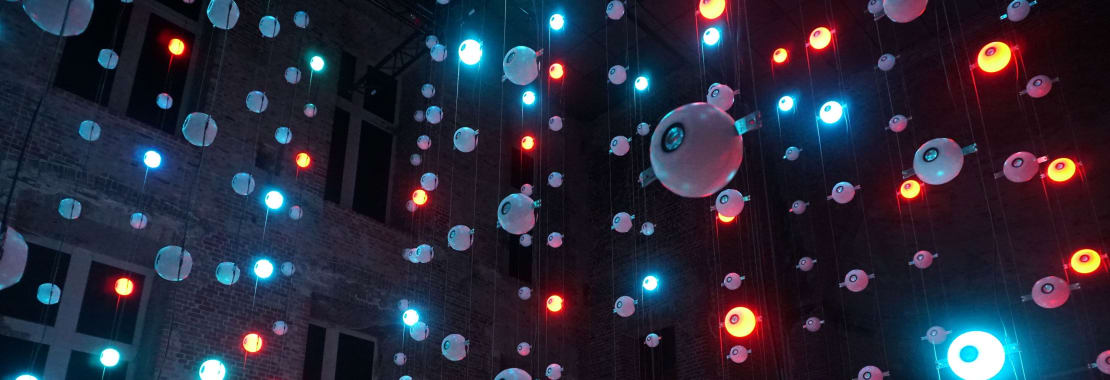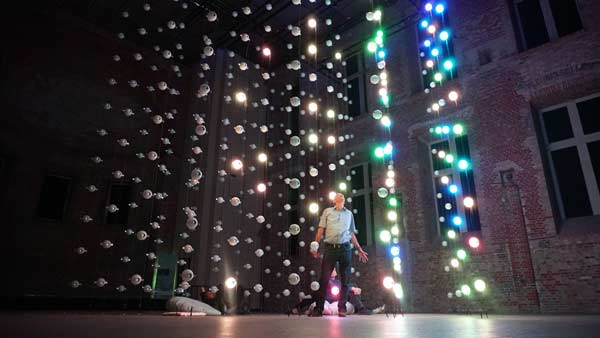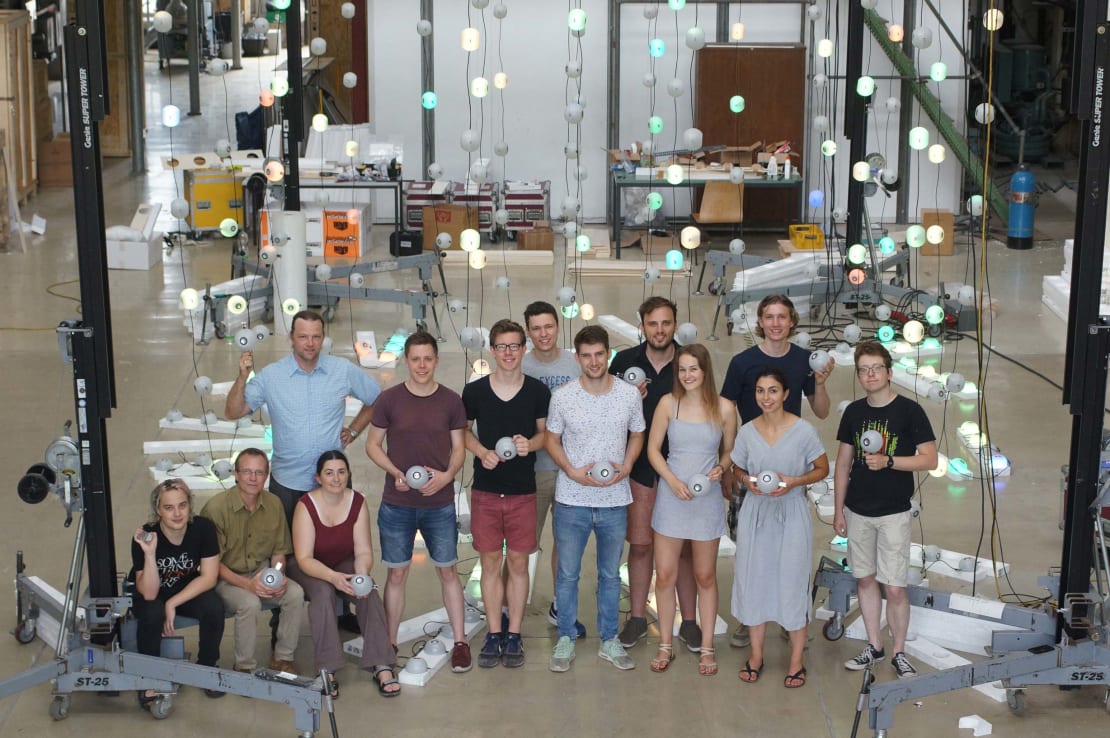
When artists and scientists meet, anything can happen. Tim Otto Roth met Christian Spiering, former spokesperson of the IceCube Collaboration, in Zeuthen. Tim was at DESY to present “Cosmic Revelations,” an installation which resembles the KASCADE cosmic ray detector in Karlsruhe. And as soon as IceCube was mentioned in a conversation between the two of them, they were hankering to work on a neutrino installation.
The culmination of their collaborative work was presented on August 28 in the empty space of a church in Berlin (Germany). The Astroparticle Immersive Synthesizer—AIS3 or [ais-kju:b]—is not only a huge piece of art, but also a sound laboratory and an experiment in psychoacoustics.
Four hundred forty-four spheres housing loudspeakers and LEDs fill up an almost cubic space of 8x8x7 meters, distributed along 37 vertical strings, thus reproducing at small scale the structure of the IceCube Neutrino Observatory, a cubic-kilometer neutrino telescope with over 5,000 light sensors buried deep in the Antarctic ice.
With this installation, Tim Otto Roth has created an immersive experience that delves into the invisible nature of neutrinos, but also of offers an allegorical visit to IceCube, which is physically inaccessible as it remains frozen in the 3-kilometer-deep ice sheet at the South Pole.

“Working on projects like this, that cross the borders between science and the arts, is extremely inspiring. In the end, art and science are twin engines of creativity,” says Spiering, who had already worked with Ken Adams––yes, Sir Kenneth Hugo Adam, the brain behind the futuristic James Bond stages and winner of two Academy Awards––in an installation based on AMANDA, the precursor of IceCube.
In AIS3, the speakers contain lights, which turn on in patterns that reflect an approximation of IceCube data. Sometimes the light starts in the center of the installation, other times it crosses the room. But these patterns, which represent light detected in IceCube as relativistic particles cross the neutrino detector, are also used to turn the space into a synthesizer, with sounds that change depending on the amount of energy represented and the distance from one acoustic source to another.
Visitors can move freely around and within the installation, developing a unique perspective on astrophysical neutrinos. Light and sound complement each other, providing an intense experience of IceCube data.
Roth also uses the low-energy detector noise. His composition transcends the twelve-tone system, producing microtonal sound movements in space. In addition, band-filtered noise translates the light tracks into an atmosphere that gives the feeling of standing in the middle of breaking waves.
The distribution of loudspeakers in a 3D grid also creates a one-of-a-kind sound experience in that the tones emitted by each sphere are recomposed in the ear of each visitor in a singular way.

Spiering started the conversation on this project, but he and DESY were not the only IceCubers working on this exhibit. At RWTH Aachen University (Germany), students under the leadership of Christopher Wiebusch and Tim Otto Roth worked on the hardware for the installation. PhD candidate Martin Rongen developed the software to transform IceCube events to the AIS3 format.
IceCubers are excited about the work created by the artist. “Tim is important for us physicists. His artwork brings us forward in our imagination,” says Elisa Resconi from TU Munich on the significance of [ais-kju:b]. And Christopher Wiebusch looks back on the process of developing the sound installation: “I am so happy that we were able to engage so many young students in this project, more than I had imagined in my wildest dreams. They have spent countless hours in the preparation of and later traveling to the exhibition in Berlin to give support to visitors.”
The exhibit closed on Sunday in Berlin with over 3,000 visitors and after a 2-day workshop about physics and the arts. AIS3 will be on display in Munich (Germany), Aix en Provence (France), and other cities around Europe in the coming months, with a grand finale in the Ludwig Forum in Aachen in September 2019.
The AIS3 exhibition and the supporting program are being funded and supported by: Hauptstadt Kulturfonds, Schering Stiftung, DESY, APPEC, RWTH Aachen/F. Victor Rolff-Stiftung, TU München/SFB 1258, Hamamatsu, Joachim Herz Stiftung, Kultur Büro Elisabeth.
+ learn more about AIS3 here.
+ Video about the project from RWTH Aachen (video in German).